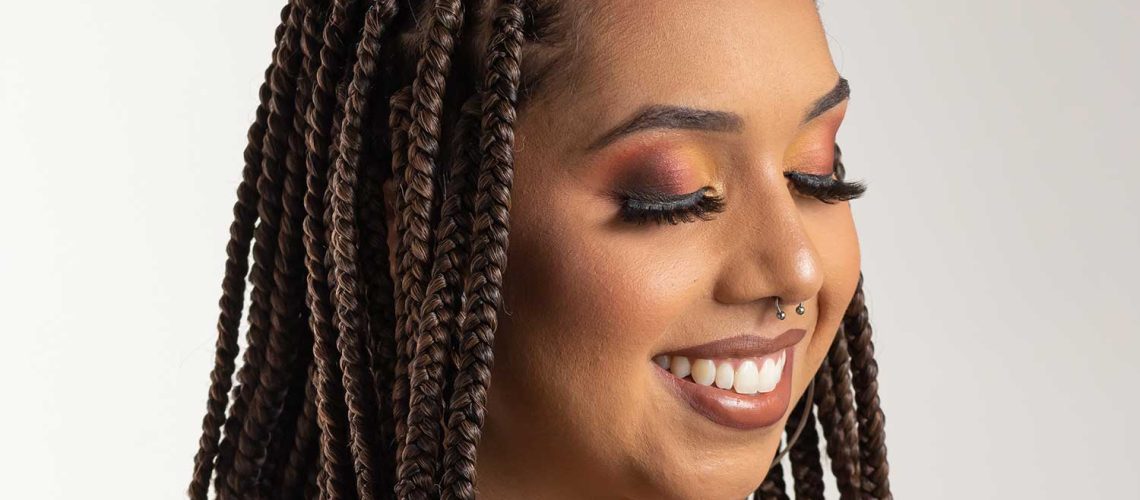In this article we will be going over Senegalese twists vs Knotless braids. There has been a lot of talk about these 2 hairstyles and we will be breaking it down for you. We’ll cover the differences of these protective hairstyles, the pros and cons, how to choose between them and tips for maintenance.
Senegalese twists vs Knotless Braids: Pros and Cons
Pros of Senegalese Twists:
- Easy to style and maintain
- Versatile and can be worn in various styles
- Can last for a few weeks up to two months with proper care
- Adds volume and length to the hair while being protective
- Works well with different hair textures, including curly or kinky hair.
- Promotes healthy hair growth
Cons of Senegalese Twists:
- Can be time consuming to install (2–4 hours) depending on how thick your braids are
- Requires more product than other hairstyles such as knotless box braids due to its intricate structure
- Braiding Hair can become heavy if too many hair extensions are used
Pros and Cons of Knotless Braids
Pros of Knotless Braids:
- Low maintenance and easy to manage
- Quicker installation time (1–2 hours) compared to Senegalese twists
- Less likely to cause tension on edges or hairline because there is no knot at the base of the braid
- Can be worn in different braided styles such as updos, ponytails, and more with ease
- Promotes healthy hair growth
Cons of Knotless Braids:
- Can feel heavier than other protective styles due to its bulkier structure
- Requires a lot of product for best results which can add up over time
- Not suitable for all hair textures since it works best with long, straight hair
How to Choose Between the Two Styles
Choosing between Senegalese twists and knotless braids largely depends on your hair texture, lifestyle, and preferences. For those who have long, straight hair, knotless braids may be a better option as they are quicker to install and require less product. However, if you are looking for more versatility in styling or have curly or kinky hair, Senegalese twists may be the way to go.
When it comes to maintenance, both styles require some upkeep but they can also last for several weeks with proper care. Knotless braids tend to require less maintenance than Senegalese twists due to their simpler structure. On the other hand, Senegalese twists offer more flexibility when it comes to styling options as you can opt for updos or ponytails and still look stylish.
In terms of comfort level and tension on your scalp and edges, knotless braids tend to be less prone to causing tension because there is no knot at the base of each braid. This makes them a good choice if you are looking for something that is comfortable and low-maintenance.
Finally, the cost should also be taken into consideration when deciding between the two. Knotless braids tend to be more expensive than Senegalese twists due to the extra product needed for installation. If cost is a factor in your decision making process then you should consider what fits into your budget before settling on a style.
It’s also important to choose the right hair braiding salon that has a lot of experience working with these types of braids. It may be tempting to try these on your own, although the amount of time, skill and the possibility of hair breakage makes more sense to go with a pro.
What’s the difference between Knotless braids vs Box Braids?
Knotless braids and box braids are two popular protective hairstyles that offer a stylish look while protecting your natural hair. Both braiding styles involve braiding the hair with extensions to create a range of looks, but there are some key differences between each style.
The primary difference between knotless braids vs box braids lies in their structure. Box braids involve three strands of hair being twisted together to form a single braid, whereas knotless braids involve two strands of hair being wrapped around each other without any knots at the base. This lack of knots makes knotless braids less bulky than box braids and gives them a more natural look.
Another difference between these two styles is in terms of installation time. Knotless braids typically take less time to install because they require fewer steps than box braids due to their simpler structure.
This makes them ideal for those who are short on time but still want to achieve a stylish look. Box braids, however, can take up to four hours or more depending on how thick the braid is, so they might be better suited for those who have a little more time on their hands.
Lastly, when it comes to maintenance and longevity, both styles require some upkeep but they can also last for several weeks with proper care. Knotless braids tend to require less maintenance than box braids due to their simpler structure and lower tension levels which can be gentler on the scalp and hairline. On the other hand, box braid styles provide more styling options such as updos and ponytails which gives them greater versatility compared to knotless styles.
Overall, choosing between knotless or box braids largely depends on your lifestyle, hair type, and preferences. Consider all of these factors before making your decision so that you can enjoy beautiful protective hairstyle without needing too much upkeep!
Tips for Maintaining Your New Hairstyle
Here are some tips to keep twists or knotless braids looking healthy and fresh:
1. Tie up your hair at night in a protective way to minimize tangles and breakage during the night time hours. Consider using a silk or satin scarf/bonnet for additional protection of your braids.
2. Use natural oils such as coconut oil or jojoba oil to keep your strands moisturized and nourished. Applying these oils to the scalp can also help soothe any irritation caused by the braiding process.
3. Avoid washing your hair too often as this can cause the hair extensions to become loose over time due to friction caused by excess water and movement in the shower. Instead, wash with a sulfate-free shampoo every two weeks and use a brush with soft bristles when detangling wet hair to avoid snags and breakage.
4. Curlformers, wands, and straightening irons should be avoided if possible as they can damage both natural hair and extensions over time when used regularly. If you must use heat styling tools, make sure to apply a heat protectant beforehand for added protection against damage from high temperatures.
5. Finally, regular trims are recommended every 4-6 weeks to maintain healthy ends and get rid of split ends that can make your hairstyle look dry and frizzy over time
Wrap-Up – Summarizing Senegalese Twists vs Knotless braids
Both Senegalese Twists and Knotless Braids are popular protective styles that offer a lot benefits. Senegalese Twists, also known as rope twists, consist of coiling two strands of hair together for plenty of volume and texture. These twists are easily customizable with the color of your choice, to achieve various looks, taking only about two to three hours on average to install.
Knotless Braids are another type of protective style that involve two strands of hair being wrapped around each other without any knots at the base. The lack of knots make them less bulky than box braids, giving them a more natural look. These braids typically take less time to install but they also require some maintenance in order to keep them looking fresh and healthy. Both styles offer versatile styling options and can last several weeks with proper care and protection at night.
Ultimately, the right style for you will depend on your lifestyle, hair type, and preferences so consider all these factors before choosing between Senegalese Twists vs Knotless braids.


